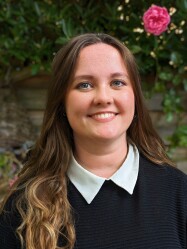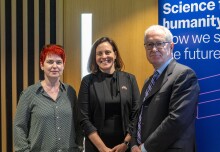
Images of Mars displayed on Imperial's Data Observatory

Data scientists propose a new method for ‘de-noising’ complex planetary data, enabling detailed analysis of Mars' surface and proposed landing sites.
Imperial researchers from the Data Learning Group and Professor Cedric John of the Digital Environment Research Institute have developed a cutting-edge AI model that effectively removes noise from hyperspectral data captured by the Compact Reconnaissance Imaging Spectrometer for Mars (CRISM).
“Our method allows for rapid and accurate denoising of CRISM imagery and helps to reveal the mineralogy of the Martian surface. This new method beats or equals benchmark CRISM denoising methods in all metrics.” Robert Platt Lead Author
This innovative denoising technique, known as Noise2Noise4Mars (N2N4M) overcomes the challenges posed by sensor degradation and the lack of surface ground truth data, enabling scientists to better extract insights about the minerology of Mars’ surface.
According to Lead Author Robert Platt, “Our method allows for rapid and accurate denoising of CRISM imagery and helps to reveal the mineralogy of the Martian surface. This new method beats or equals benchmark CRISM denoising methods in all metrics.”
By enhancing the quality of CRISM data, this AI-powered tool promises to enhance our understanding of Mars’ surface mineralogy, helping to infer past environmental conditions on Mars and identifying new areas for exploration and discovery on the Red Planet.
Noisy data!
Hyperspectral data refers to imaging data that captures detailed information from a range of wavelengths across the electromagnetic spectrum, providing important information about the surface mineralogy – we use this to infer details of the geological evolution of Mars among other things.
The hyperspectral data collected by the Compact Reconnaissance Imaging Spectrometer for Mars (CRISM) on-board NASA’s Mars Reconnaissance Orbiter mission has allowed for the highest resolution spectral mapping of the Martian surface to date.
Over time however, the quality of the imagery has degraded as the camera has aged, making it unusable due to high noise levels. This is a significant problem for areas that have only been recently identified as sites of interest since the camera began degrading, such as Oxia Planum, the landing site for ESA’s Rosalind Franklin ExoMars mission.
A lack of ground truth data, and the manual data processing required represents further challenges that prevent rapid and accurate analysis.
A new denoising method
To overcome these challenges, the team introduced a novel approach using a specific type of neural network architecture called a self-supervised Convolutional Neural Network in a U-Net architecture. This means the system can learn to understand and process data without needing explicit labels or supervision from humans.
By training the model on noisy data and leveraging features unique to hyperspectral imagery such as spectral information, they were able to develop a method that could remove noise while preserving critical absorption features such as those necessary to identify minerals on Mars’ surface.
According to Platt: “Our method considers the image on a pixel-by-pixel basis, but spatial noise “stripes” are evident in the images. Whilst these “striping” artefacts are mitigated by our approach, they are not targeted directly, and remnants persist.
“We aim to improve this by directly integrating this spatial component of the noise into our model by adding 2D or 3D convolutional layers to improve denoising capabilities.”
The code used to develop this method is now available online for anyone to use.
Advancing planetary sciences
By improving the denoising of hyperspectral signals, this research not only enhances mineral identification and analysis on Mars but also sets a precedent for the application of self-supervised machine learning methods in planetary sciences.
The potential impact of this work extends beyond Mars, opening doors for similar advancements in other domains such as synthetic aperture radar and radio signals.
Use of this method will allow for further and more widespread detailed analysis of Oxia Planum and other sites across Mars and could help inform future landing sites and mission objectives.
-
Robert Platt will be presenting this work as part of the Machine Learning for Remote Sensing (ML4RS) Workshop of ICLR 2024 in Vienna next week (11th May 2024).
‘Noise2Noise Denoising of CRISM Hyperspectral Data’ by Platt, Arcucci, and John published on 26 March 2024 as part of ICLR 2024 Machine Learning for Remote Sensing (ML4RS) Workshop.
Article text (excluding photos or graphics) © Imperial College London.
Photos and graphics subject to third party copyright used with permission or © Imperial College London.
Reporter

Gemma Ralton
Faculty of Engineering

Contact details
Email: gemma.ralton@imperial.ac.uk
Show all stories by this author



